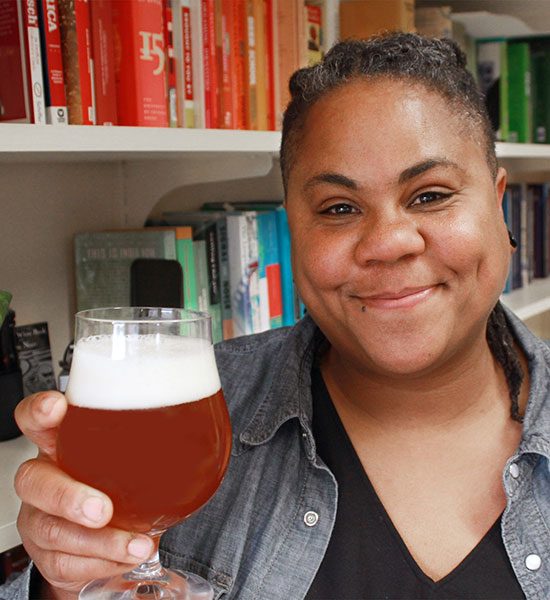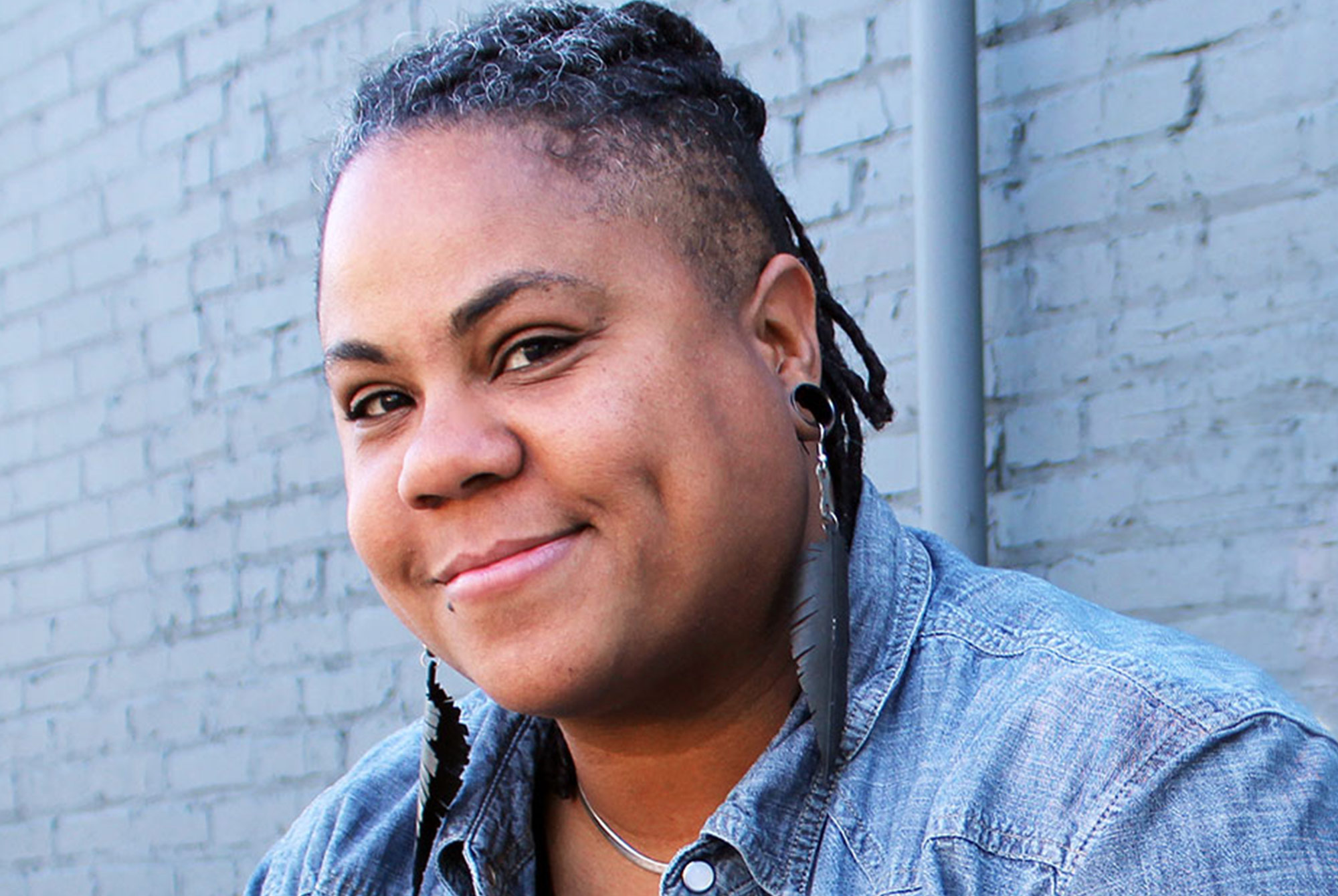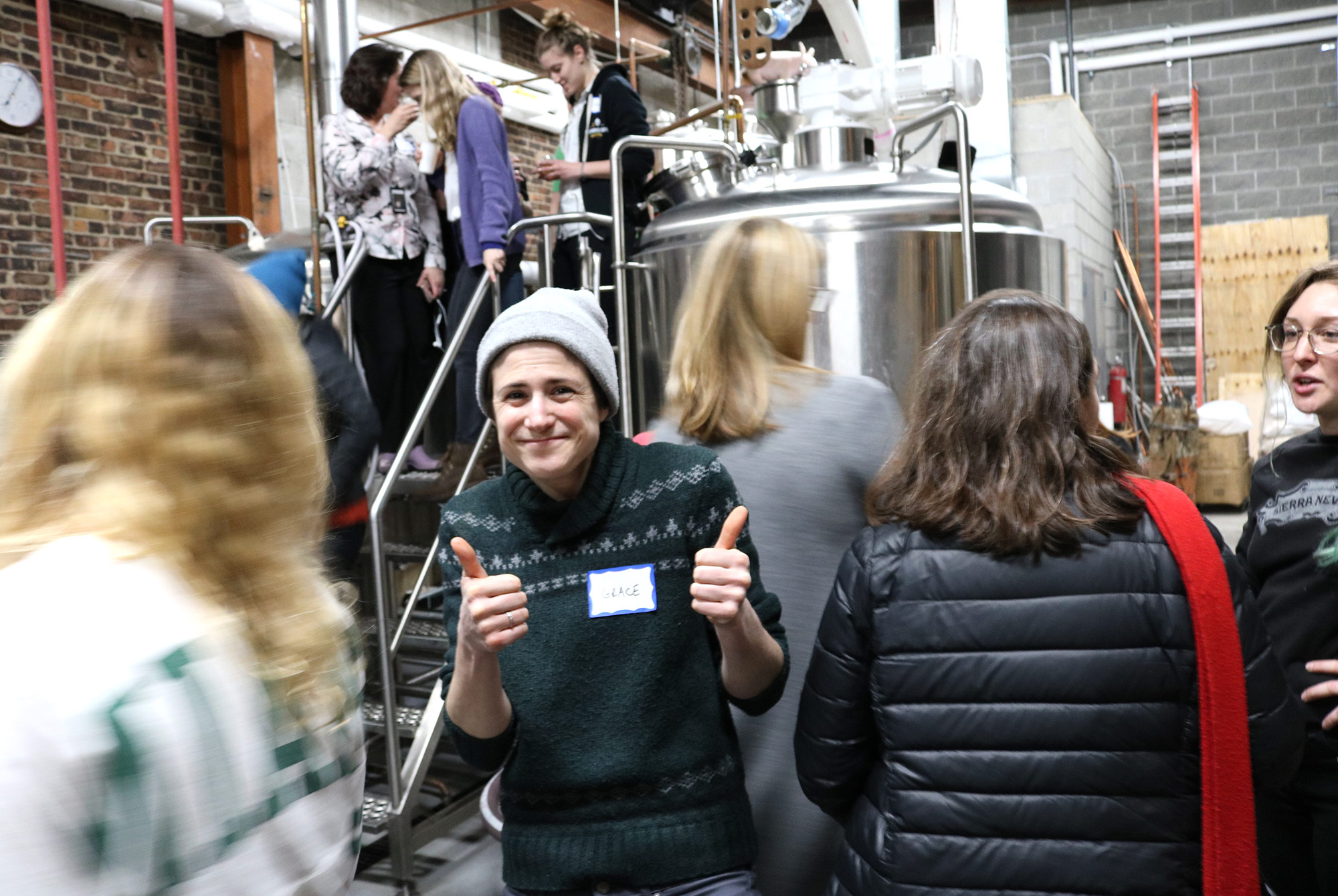Shop
A Pint with J. Nikol Jackson-Beckham, The BA’s Diversity Ambassador
A chat at the intersection of academia and beer.
To catch more discussions and Q&A’s like this one check out our full page of events during Beers With(out) Beards Week.
Three months ago a headline caught my eye, “Brewers Association Names First Diversity Ambassador at the Brewers Association.” Up to my neck planning events for our inaugural Women in Craft Beer Festival, Beers With(out) Beards, I clicked on the article for inspiration.
A smiling J. Nikol Jackson-Beckham, Ph.D stared back at me. Holding a glass of amber colored liquid in front of shelves upon shelves of multicolored books, Jackson-Beckham seemed at ease in her surroundings – the intersection of academica and beer. Currently, an Assistant Professor of Communication Studies at Randolph College, Jackson-Beckham’s published works have critically examined beer and American culture.
As the new diversity ambassador for the BA, Jackson-Beckham has been tasked with traveling around the country combining her years of studying and publishing articles on beer and culture with sharing practices for embracing diversity within craft beer.
Similarly, Beers With(out) Beards seeks to empower the role of all women in beer. Through a weeklong celebration featuring 12 exclusive events from industry panels and beer dinners to beer trivia and beer yoga, BW(O)B culminates in a tasting festival with 20+ of the top female-led breweries in the country.
With the word diversity on my mind, I contacted Jackson-Beckham for a chat about how to successfully define diversity in craft beer (hint: there isn’t just one way) and how Michael Jackson’s Beer of the Month Club and a job at a ‘brew-and-grow’ retailer led to a profession at the BA.
Grace Weitz: Describe your first experience with craft beer. What beer did you drink? What went through your mind as you drank it?
J. Nikol Beckham-Jackson: I worked at a sports bar while I was an undergraduate student in Southwest Virginia in the late 1990s. Occasionally, after a long hard night, employees would be rewarded with a shift beer. At the time, my beer tastes leaned decidedly more toward volume than quality. But, being an opportunistic young woman, I took the opportunity to drink the most expensive offering on the draft list. Not long after that, I started opting for the “expensive” beers with regularity.
Weitz: Why were you initially drawn to the craft beer community?
Beckham-Jackson: I’m drawn to people who think, to people who are passionate, to people who are curious, to people who make things, to good conversations, to people who see things in new or strange or interesting or expansive ways. That begins to get at it, but honestly, I’m not sure this can be easily put into words. Craft beer people have always just seemed to be my people.
Weitz: What led you to apply to be the BA’s diversity ambassador?
Beckham-Jackson: Wow…this is a long winding story.
Shortly after completing my undergraduate degree, I was given a subscription to Michael Jackson’s Beer of the Month Club as a birthday gift. I still consider it among the best gifts I have ever received. I was completely entranced with the idea of tasting my way around the country through this box that landed on my doorstep once a month.
As fortune would have it, at the time I started working for a company that performed needs analysis for proposed affordable housing developments. The job sent me to potential building sites all over the country. On average, I spent two days a week traveling alone, hundreds or even thousands of miles away from my tiny condo in DC. Local bars and brewpubs became places to combat loneliness, avoid the boredom of airport terminals (this was in the days of dial-up and pre-Netflix streaming), grab a bite to eat, and as it happened, taste dozens upon dozens of local and regionally brewed beers.
I moved to San Diego in 2003 and what was a private hobby became a full-blown obsession. I sort of jumped into that scene with both feet—homebrewing, festivals, beer dinners, brewery tours, bottle shops. It was a really awesome place and time to discover the craft beer community.
By the time I returned to the east coast to begin a Ph.D. program at UNC-Chapel Hill in 2007, my perspectives on beer were virtually incomparable to those I’d held a little less than a decade earlier. Most significantly, I was just thinking about beer a lot. Not just drinking and making it, but the roles that beer has played and continues to play in American culture. And with some luck and a lot of persuading, I managed to convince my dissertation committee that a research project about beer and culture was a good idea.

I committed myself to learning as much as I could about craft beer. I got a job at a ‘brew-and-grow’ retailer (they sell organic gardening, hydroponics, and homebrew supplies). I taught homebrew classes, so I had a lot of motivation to keep pushing my technical knowledge of brewing. I was buying supplies and equipment for five locations, so I formed some really informative relationships with equipment, malt, hop, and yeast suppliers. I joined the Pink Boots Society. I studied for and passed the BJCP exam (though I never had the time to follow up and move past provisional status). I started blogging about beer (and shockingly getting a sizable audience), visiting a lot of breweries for my research, beginning to do some public speaking about beer and culture, and generally meeting a lot of really awesome people.
On the academic side of things, my work started to find a niche and a community of other scholars who were doing interesting work on beer. I published a chapter called “Drinking Local”: Sustainable Brewing, Alternative Food Networks, and the Politics of Valuation, which appeared in an edited collection called Food and Everyday Life in 2014. Another chapter called Entrepreneurial Leisure and the Microbrew Revolution: The Neoliberal Origins of the Craft Beer Movement was published in the collection, Untapped: Exploring the Cultural Dimensions of Craft Beer in 2017. And I currently have a book under contract with the University of Nebraska Press, tentatively titled The Value of a Pint. But honestly, a blog series I started in 2012 called “The Unbearable Whiteness of Brewing” is probably most responsible for people finding my work and for me really digging into the question about diversity and craft beer.
And I wasn’t alone. Other people really wanted to dig into this question too, so I found myself doing a lot more media appearances and talks. For those of us in academia, new questions or underexplored questions (because my dissertation research wasn’t really “about” diversity-related issues) drive us to do more research. So I dug into the scholarly literature about diversity in industries and organizations to learn as much as I could about what works and why.
I ran into Julia Herz at the North Carolina Craft Brewers conference in November 2017. I was there giving a plenary talk about diversifying craft beer (of all things). We didn’t have an extended conversation at the time, but I walked away from that meeting with the understanding that the Brewers Association intended to do something really thoughtful and meaningful around diversity and inclusion and I was excited to see what it would be. Of course, I had absolutely no clue that they intended to create an ambassador position or that I would eventually be considered for it at the time.
So, ALL OF THAT is to say, I applied for this position because it honestly feels like the culmination of things that have been brewing (sorry) for a long time.
Weitz: There’s this dichotomy in craft beer between being a very friendly and inclusive community while simultaneously being composed of predominantly white men with beards. What kind of stereotyped experiences have you had in the craft beer industry?
Beckham-Jackson: It’s been like a slow and constant drip of the same “little” experiences over and over—seemingly innocuous, but mountains are dissolved in the same way. There are lot of ways, some intentional but I suspect mostly unintentional, that one can communicate to someone else, “I don’t think that you belong in this community.” That isn’t the same as saying, “I don’t want you to be part of this community.” But it is extremely important to recognize that the outcomes of both of those messages are often the same.
Weitz: What are the top three steps breweries can take to embrace more diversity?
Beckham-Jackson: I am going to make an academic’s move and answer your question with a question. What if instead of “diversity,” you were talking about “success.” If someone were to ask, “what are the top three steps you can take to create a successful brewery?” responses would probably come in one of two flavors. 1) A short list of fairly abstract notions like “be authentic” or “set realistic goals” or 2) a long and silent pause as the answerer considers how the asker intends to define success. Does “success” mean rapid growth and an eventual sale? Does “success” mean staying sustainably small without incurring a mountain of debt? Does “success mean pioneering a new model of delivering products to consumers? Does success mean winning awards and recognition? Does success mean simply staying open for 5 years? As you can probably guess, I am of the “number 2” camp. Just as you have to define “success” before you start parsing out the steps you need to take to achieving it, I believe you have to define what “embracing more diversity” looks like in terms of your organization, your goals, and your community, before you start defining steps.
Weitz: What is your definition of diversity in craft beer?
Beckham-Jackson: I don’t really have a personal definition and I think that’s a good thing. I’m excited and inspired by the countless ways those in the industry are already finding ways to open the doors for groups of people who have been underrepresented as drinkers and producers. I would hate to impose a narrow or single-minded vision on what diversity in craft beer might look like. That is to say, diversity itself can and should be diverse and multifaceted.
Weitz: What part of the job are you most looking forward to as the new diversity ambassador?
Beckham-Jackson: The research. It’s what I do. But to be honest, academic research can be like pouring your heart and soul into a void. And more to the point, a lot of academic research is diagnostic or downright critical. Pointing out problems is not the same as coming up with solutions. So, I am excited about using research to help brewers maximize the opportunities that being intentional about diversity and inclusion can produce.
Weitz: What beer are you drinking at the moment?
Beckham-Jackson: I have been drinking a lot of rye beers. I plan to brew something soon and have been getting acquainted.
Liked this article? Sign up for our newsletter to get the best craft beer writing on the web delivered straight to your inbox.




